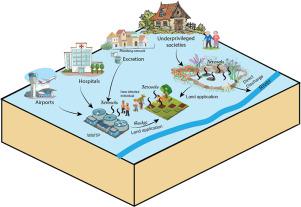Science of the Total Environment ( IF 8.2 ) Pub Date : 2020-07-03 , DOI: 10.1016/j.scitotenv.2020.140709 Muhammad Arslan 1 , Bin Xu 2 , Mohamed Gamal El-Din 1

|
The advent of novel human coronavirus (SARS-CoV-2) and its potential transmission via fecal-oral and aerosols-borne routes are upcoming challenges to understand the fate of the virus in the environment. In this short communication, we specifically looked at the possibilities of these transmission routes based on the available literature directly related to the SARS-CoV-2 as well as on the closer phylogenetic relatives such as SARS-CoV-1. The available data suggest that, in addition to human-to-human contact, the virus may spread via fecal-oral and aerosols-borne routes. Existing knowledge states that coronaviruses have low stability in the environment due to the natural action of oxidants that disrupt the viral envelope. Previous recommended dosage of chlorination has been found to be not sufficient to inactivate SARS-CoV-2 in places where viral load is high such as hospitals and airports. Although there is no current evidence showing that coronaviruses can be transmitted through contaminated drinking water, there is a growing concern on the impact of the current pandemic wave on underprivileged societies because of their poor wastewater treatment infrastructures, overpopulation, and outbreak management strategies. More research is encouraged to trace the actual fate of SARS-CoV-2 in the environment and to develop/revise the disinfection strategies accordingly.
中文翻译:

SARS-CoV-2 通过粪口和气溶胶传播途径传播:环境动态及其对贫困社会废水管理的影响。
新型人类冠状病毒(SARS-CoV-2)的出现及其通过粪口和气溶胶传播途径的潜在传播,是了解该病毒在环境中命运的即将到来的挑战。在这篇简短的交流中,我们根据与 SARS-CoV-2 直接相关的现有文献以及 SARS-CoV-1 等更近的系统发育亲属,专门研究了这些传播途径的可能性。现有数据表明,除了人际接触外,病毒还可能通过粪口和气溶胶传播途径传播。现有知识表明,由于氧化剂破坏病毒包膜的自然作用,冠状病毒在环境中稳定性较低。人们发现,之前推荐的氯化剂量不足以在医院和机场等病毒载量较高的地方灭活 SARS-CoV-2。尽管目前没有证据表明冠状病毒可以通过受污染的饮用水传播,但人们越来越担心当前的大流行浪潮对贫困社会的影响,因为这些社会的废水处理基础设施薄弱、人口过剩和疫情管理策略不佳。鼓励开展更多研究来追踪 SARS-CoV-2 在环境中的实际命运,并相应地制定/修改消毒策略。











































 京公网安备 11010802027423号
京公网安备 11010802027423号